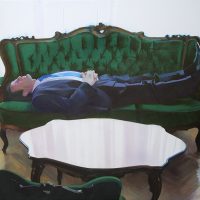olaj, vászon / oil on canvas, 160 x 240 cm, 2012, Knoll Galéria
(Fotó: Tihanyi-Bakos Fotó Stúdió)
olaj, vászon / oil on canvas, 80 x 100 cm, 2012, Knoll Galéria
(Fotó: Tihanyi-Bakos Fotó Stúdió)
The title of the exhibition can be read partly as the reflection to the traditionally strongly mystified studio work as the tradition of the crafts and partly to the general interpretation of the painter’s role. What shall the painter commit himself to? Does he have a duty at all, or he just has duties? The artistic path of Ákos Birkás, full of definite turns -from the early photorealist paintings, through the fine arts usage of photo and the abstract painting, to the figurative and narrative pictures- gives more answers to these questions, as this oeuvre, despite of all powerful changes, is a consistent medium-analysis, an example of the research of painting and (self)analysis of the artist and the artwork.
The exhibition, divided into three sections, presents the painter’s latest artistic period that is continuously in dynamics; pictures that initially caused surprise and even astonishment for many. According to the paintings that are based on press images, analysing the relation of picture and text, the works that recall Christian iconography and the latest works that seem to brake with the artist’s fine painting style, Birkás’ main questions relate to the interplay of aesthetics and politics in an era when many people don’t want to know about this or they emphasize it too loudly. The topics and works of peculiar decorativeness lead to the taste-community of social existence, the issue of me and the Other and discuss the possibilities of the language of painting. And if we think that these two factors are independent from each other then we can be convinced by Birkás’ painting that is free of aggression, sensitive and forms sensitivity.

